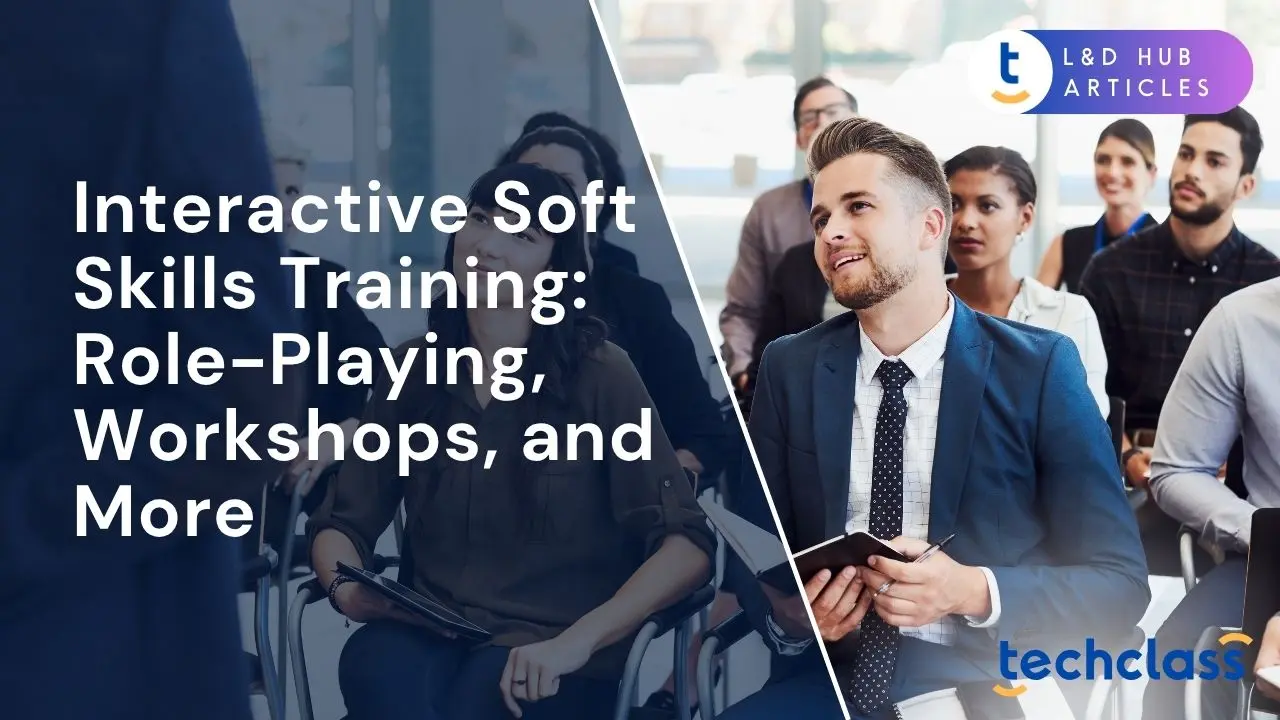
Soft skills like communication, teamwork, and leadership have become essential in every industry. Yet teaching these interpersonal abilities is challenging because they aren’t learned well through memorization or lectures. Traditionally, companies relied on slide presentations or one-off seminars to train soft skills, but these passive methods often fail to change behavior. In fact, employees acquire up to 70% of their skills through on-the-job experience rather than formal classroom training. This is why interactive soft skills training is gaining traction, it actively engages participants in practicing the skills, leading to better retention and real behavioral improvement. For example, research shows that hands-on, active learning can dramatically boost retention: one study found learners retained 93% of information after one month with active, practice-based training, versus only 79% retention after passive learning. Moreover, companies see clear benefits when they invest in soft skills development. A notable study by MIT Sloan at an Indian manufacturing firm showed that a 12-month soft skills training program delivered a 250% return on investment (ROI) within the first year. In short, interactive approaches not only help employees learn more effectively, but they also translate into tangible gains for organizations.
Given the high stakes, HR professionals and business leaders are exploring dynamic training methods, from role-playing exercises to hands-on workshops and gamified learning, to cultivate these critical soft skills. In this article, we will break down what interactive soft skills training entails, why it works, and how you can implement it. You’ll learn how techniques like role-playing scenarios, collaborative workshops, and simulations can make soft skills training more engaging and impactful for your team.
Interactive training methods are effective because they transform learners from passive listeners into active participants. Soft skills, such as conflict resolution, empathy, or presentation skills, are fundamentally learned by doing. In an interactive session, employees must actively communicate, solve problems, and make decisions, just as they would in real workplace situations. This practical experience is invaluable. It not only reinforces learning but also builds confidence. Participants can experiment with different approaches in a safe setting and learn from immediate feedback.
Another reason interactivity matters is engagement. When training is interactive, it’s inherently more engaging and fun. Learners are more attentive and motivated, which means they absorb more. This helps combat the common problem of employees mentally checking out during dull training sessions. It’s no surprise that 68% of employees say they prefer to learn on the job through hands-on experience rather than formal training alone. Interactive methods harness this preference by mimicking on-the-job learning in a structured way. They also encourage peer learning, employees learn from each other’s perspectives during group activities or role-plays, which enhances the experience.
Crucially, interactive soft skills training tends to yield better long-term results than lecture-based training. Active involvement helps commit concepts to long-term memory (as the earlier retention statistics show). Employees are more likely to internalize behaviors like active listening or teamwork if they have practiced them during training. By contrast, simply hearing about these concepts in a lecture often isn’t enough to change day-to-day behavior. Furthermore, interactive training can boost morale and signal that the company values employee growth. According to a workplace learning report, 94% of workers are more likely to stay at a company that invests in their training and development. Clearly, making soft skills training engaging and relevant pays off in both performance and retention. In the next sections, we’ll explore specific interactive techniques, role-playing, workshops, and more, and how they help develop valuable soft skills.
Role-playing exercises place employees in realistic scenarios where they must practice soft skills by acting out roles. For example, one employee might play an upset client while another plays a support agent handling the complaint. By simulating such interactions, role-playing creates a hands-on learning experience that mirrors real challenges. This method lets participants learn by doing in a safe environment. They can test different approaches to see what works, without real consequences for mistakes. As a result, role-play is a powerful tool for building skills like communication, empathy, and problem-solving. It supports active learning by forcing learners to apply their knowledge and abilities to solve problems in specific situations. Rather than just talking about how to handle a difficult conversation or negotiate a deal, employees actually practice it during the role-play.
One major benefit of role-playing is that it helps individuals understand different perspectives. By assuming a role, an employee can “step into someone else’s shoes”, be it a customer, a teammate, or a manager, and experience how interactions feel from that viewpoint. This builds empathy and better communication habits. Role-play also provides immediate feedback. After a scenario ends, participants and observers can debrief: What went well? What could be improved? This reflective feedback loop helps refine soft skills on the spot. For instance, a manager rehearsing a performance review conversation in a role-play might discover that their tone came off as too harsh, and then adjust their approach accordingly in the next round.
Role-playing is versatile and can be used for many soft skills domains. Companies commonly use it for customer service training (practicing handling complaints or inquiries), sales training (practicing sales pitches and objection handling), leadership and coaching (practicing one-on-one feedback sessions or conflict resolution between team members), and much more. Modern e-learning tools have even made it possible to do role-play simulations digitally. Scenario-based e-learning modules can present branching situations where employees choose how to respond, effectively “role-playing” with computer-driven characters. This allows scalable soft skills practice for large teams. Whether conducted in person or via a virtual platform, role-play exercises provide that crucial element of learning by experience. Participants walk away not just with theoretical knowledge, but with actual practice under their belt in handling tricky interpersonal situations.
A real-world example of role-playing in action comes from a recent corporate workshop on coaching skills. In this program, managers were grouped into triads to role-play coaching conversations: one person played the coach, one played the employee being coached, and one observed. Using a specialized virtual classroom tool, the facilitator was able to drop in on each trio’s role-play and give guidance. The result was a highly engaging session, participants reported that the interactive practice was far more enlightening than just watching slides on coaching. Many said the role-plays revealed nuances of their communication style they hadn’t noticed before, and they appreciated the chance to experiment in a supportive setting. This kind of feedback underscores how effective role-playing can be at bringing soft skills training to life.
Interactive workshops are training sessions designed to be participatory, where employees actively collaborate and engage in activities to develop soft skills. Unlike a traditional seminar where an instructor talks and the audience listens, an interactive workshop involves constant two-way interaction. Participants might break into small groups to discuss ideas, work through case studies, perform team exercises, or engage in role-play scenarios. The workshop facilitator’s role is more of a coach or moderator, guiding activities and discussions rather than lecturing nonstop. This format creates a rich learning environment in which employees learn with and from each other.
One key advantage of workshops is the opportunity for peer learning and feedback. People from different departments or roles can share their experiences and approaches to common challenges. For example, in a communication skills workshop, one participant might share a difficult client interaction they handled, and the group can analyze it and suggest alternative strategies. These discussions allow employees to gain insights and practical tips from colleagues that they can apply in their own work. Workshops also build teamwork skills by their very nature, when employees collaborate on a task or problem in the session, they practice listening, brainstorming, and reaching consensus. This not only teaches the content at hand (say, problem-solving techniques or conflict resolution methods) but also strengthens the participants’ general ability to work together.
Interactive workshops are often led by an expert or trainer who can introduce frameworks or models (for instance, a model for giving constructive feedback) and then immediately have participants practice them in an exercise. This immediate application cements understanding. Attendees might pair up to role-play a feedback conversation, or split into teams to solve a hypothetical workplace conflict. Because the sessions are live and interactive, the facilitator can observe and coach in real time, offering suggestions, correcting misunderstandings, and highlighting successes. Participants receive instant feedback on their performance, which is incredibly valuable for soft skills that can be hard to self-assess. It’s much easier to recognize that you interrupted someone too often during a mock discussion when a colleague points it out in the workshop, rather than discovering it during a real client meeting.
Workshops also tend to be more engaging and enjoyable for employees, which improves learning outcomes. Activities like games, group challenges, or even friendly competitions (such as which team can come up with the best solution to a case study) keep energy levels high. People often remember these interactive experiences more vividly than they would remember slides or readings. Additionally, workshops provide a networking and bonding opportunity. Especially in larger organizations, a soft skills workshop can bring together employees from different teams who don’t typically work together. As they collaborate in exercises, they build rapport that can carry back to the workplace, enhancing the company culture.
To be effective, interactive workshops should be well-structured with clear learning objectives and a variety of activities to suit different learning styles. Mixing discussion, hands-on practice, and brief instructional segments keeps everyone engaged. It’s also important to keep workshops practical, focusing on scenarios and challenges that participants truly face in their jobs. That way, employees see the relevance and are more motivated to participate. Many successful corporate training programs use a series of workshops spread over time (for example, a leadership development curriculum might involve monthly workshops, each on a different soft skill like communication, coaching, diversity, etc.). This gives employees continual practice and reinforcement of skills.
Overall, interactive workshops create a safe space where employees can stretch their soft skills, make mistakes and learn from them, and gain confidence. The collaborative, supportive atmosphere often sparks insight and behavior changes that simply don’t emerge from solitary online courses or passive lectures. By investing in well-designed workshops, organizations can significantly improve team communication, leadership pipelines, and the overall interpersonal effectiveness of their workforce.
Beyond role-plays and workshops, companies are also turning to gamification and simulations to enhance soft skills training. These methods leverage technology and game design to make learning interactive and fun. Gamification involves incorporating game elements into training activities, things like point systems, leaderboards, badges, timed challenges, or rewards for completion. For example, an online soft skills course might give users points for successfully navigating a difficult conversation scenario, and display a leaderboard to spark friendly competition among coworkers. The idea is that the same features that make games engaging can motivate employees to practice soft skills. Gamified training exercises work especially well for skills that benefit from repetition and practice, such as negotiation techniques or customer service protocols. Employees become eager to “win” or beat the game, and in the process, they repeatedly rehearse the desired behaviors.
Interactive simulations take training a step further by immersing learners in lifelike situations. In a simulation, employees might be placed in a virtual scenario, say, a simulated client meeting or a team project, where they must make decisions and respond just as they would in reality. High-tech simulations can include virtual reality (VR) environments or AI-driven role-play partners. For instance, using VR, a trainee can put on a headset and find themselves in a virtual boardroom delivering a presentation to an audience of virtual characters. This kind of simulation triggers the same emotions and pressure as the real situation, helping the learner practice managing nerves and thinking on their feet. Even without VR, simpler branched simulations (through a computer or tablet) can present realistic dialogues and problems. The trainee’s choices lead to different outcomes, and they can see the consequences of their communication style or decisions.
These simulated experiences are incredibly valuable for soft skills development. They allow employees to experience consequences in a safe environment. If someone chooses the wrong approach, for example, responding rudely to a customer in a simulation, they can see the negative outcome (an angry customer and a lost sale in the simulation) and learn from that mistake, without any actual business harm. Simulations also often provide built-in feedback. After completing a scenario, the program might give the user a score or explain what they did well versus where they went off-track. This instant feedback helps reinforce learning points immediately.
Gamification and simulations are especially useful for engaging younger, tech-savvy employees who may expect interactive, game-like experiences in many aspects of life. However, employees of all ages can find value in these methods. A well-designed simulation or game can tap into our natural curiosity and competitive spirit, making the process of learning soft skills enjoyable rather than tedious. For example, a teamwork training game might involve a group of employees collaborating to solve a virtual puzzle under time pressure, mirroring the communication and coordination needed in real projects, but in a playful context. Participants often get so engrossed in “beating the game” that they don’t even realize how much they are practicing their communication, leadership, and problem-solving skills.
Companies have started to see impressive outcomes from these approaches. Gamified e-learning modules for soft skills have been shown to increase completion rates and knowledge retention compared to traditional e-learning. Some organizations use point-based challenges where employees earn rewards for completing certain soft skill courses or for demonstrating skills on the job (as verified by managers). This creates a culture where developing soft skills is incentivized and celebrated. Meanwhile, advancements in AI and virtual reality are making simulations more accessible. For instance, there are now AI-based coaching tools where an employee can practice a sales pitch by speaking to their computer’s camera; the AI avatar responds like a real client would, and then the program analyzes the employee’s eye contact, tone, and word choice to give feedback. These innovations provide highly personalized, interactive practice sessions that were not possible just a few years ago.
In summary, gamification and simulations enrich soft skills training by introducing interactivity, realism, and motivation. They complement in-person methods like workshops and role-plays, and are particularly useful for scaling training to large groups or remote employees. By learning through play and simulation, employees can build critical soft skills in an engaging way, honing their abilities to communicate, lead, and adapt under various scenarios, all while enjoying the learning process.
Implementing an interactive soft skills training program in your organization requires thoughtful planning. Here are some key steps and best practices to ensure success:
1. Assess skill gaps and needs: Start by identifying which soft skills your employees or teams most need to improve. You can gather this information through surveys, performance reviews, or simply by asking managers where they see communication breakdowns or teamwork issues. By pinpointing the priority areas, be it customer communication, leadership, time management, or others, you can tailor the program to focus on the most relevant skills. This assessment ensures you’re addressing real workplace challenges and makes the training feel purposeful to participants.
2. Choose the right interactive methods: Once you know your target skills, decide on the training formats that fit your audience and goals. There are numerous interactive methods to consider, and often a blend works best. For example, you might use role-playing exercises to practice client interactions, workshops for team-building and communication fundamentals, and gamified e-learning modules for ongoing practice and reinforcement. The choice may also depend on logistical factors: a dispersed workforce might benefit from virtual simulations and video-conference workshops, whereas an in-office team could do more in-person role-play sessions. It’s important to select methods that your employees will be comfortable with and engaged by. If possible, involve some employees or managers in the planning, they can provide insight into what formats will resonate. Remember, the goal is to make training engaging, so lean towards interactive options over traditional lectures whenever you can. For instance, if you have an existing slide deck on customer service techniques, consider transforming it into a series of interactive scenarios or a facilitated workshop activity.
3. Secure buy-in and support: Leadership support is crucial for any training initiative, especially one that may be a bit different from the norm. Communicate to executives and managers the benefits of interactive soft skills training, use data and examples (like those mentioned earlier) to make the case that this will improve performance and potentially ROI. When managers buy in, they will encourage their teams to take the training seriously and create space in work schedules for employees to participate. It also helps to explain to employees why this training is being done and how it will benefit them professionally. When people understand that the company is investing in their growth (and not just checking a box), they come to sessions with a more positive, open mindset.
4. Foster a safe learning environment: For interactive training to work, participants need to feel safe to speak up, make mistakes, and be candid. Emphasize ground rules at the start of workshops or role-play sessions, for example, confidentiality (what’s shared in training stays in training) and a judgment-free attitude. Trainers should role-model respect and positive reinforcement. If employees fear embarrassment or criticism, they’ll hold back and the interactivity loses value. One effective technique is to start with low-stakes icebreaker activities or very simple role-plays to get everyone comfortable. As trust builds, participants will engage more fully in deeper simulations or discussions.
5. Provide continuous feedback and coaching: Interactive soft skills training shouldn’t be a one-and-done event. To really change behaviors, people need ongoing feedback and opportunities to practice. During sessions, facilitators should provide constructive feedback, highlighting what was done well (“Great use of open-ended questions in that role-play”) and what could be improved (“Remember to maintain eye contact; let’s try the scenario again with that in mind”). After formal sessions, consider setting up additional reinforcement mechanisms. This could include coaching follow-ups, peer mentoring, or refresher micro-learning modules. Even simple check-ins, like a manager asking “How are you applying the negotiation tactics we learned last month?”, can prompt employees to keep using their skills on the job. Some organizations create social learning groups or discussion boards where employees share stories of how they applied soft skills training in real situations. This keeps the momentum going and lets everyone learn from each other continuously.
6. Measure and iterate: To ensure your interactive training program delivers results, decide how you’ll measure success. Possible metrics include employee feedback on the training (via surveys), improvements in specific workplace outcomes (fewer customer complaints after a customer service workshop, faster project completion after a teamwork workshop, etc.), or assessments of skill growth (before-and-after role-play evaluations, scores in simulations, etc.). For example, you might track whether teams that underwent soft skills training show higher employee engagement scores or lower staff turnover in subsequent months. Use the data to refine your approach, maybe participants loved the role-playing but found the e-learning game boring, indicating you should adjust the gamification elements. Treat the implementation as an iterative process. By continuously improving the content and format based on feedback, you’ll build a program that stays relevant and effective over time.
By following these steps and remaining flexible, you can successfully embed interactive soft skills training into your organization’s learning culture. It may start as a small initiative, a single workshop or a pilot program for a department, but over time, these interactive methods can become a core part of how your company develops its people. When done well, soft skills training programs pay dividends in employee performance, better teamwork, higher customer satisfaction, and even bottom-line results.
Interactive soft skills training is more than a one-time event, it’s a gateway to creating a culture of continuous learning and improvement. By utilizing role-playing exercises, collaborative workshops, games, and simulations, organizations signal that learning is active and ongoing. Employees come to see training not as a tedious requirement, but as an engaging process where they can experiment, receive feedback, and grow. Over time, this fosters an environment where people feel empowered to develop themselves and help others improve too.
For HR professionals and business leaders, the message is clear: investing in interactive soft skills development is investing in your organization’s long-term success. Strong soft skills lead to teams that communicate better, leaders who inspire, and employees who adapt quickly to change. These qualities directly impact productivity, innovation, and employee retention. And as we’ve seen, the most effective way to nurture these skills is through methods that bring learning to life, whether it’s a lively role-play session that teaches empathy in customer service, or a simulation game that sharpens decision-making under pressure.
In every industry, human-centered skills are what make the difference between a good team and a great team. Technology and technical expertise alone are not enough; companies also need collaborators, critical thinkers, and empathetic communicators. Interactive training provides the practice ground to hone those abilities. It creates memorable learning experiences that stick with employees far beyond the classroom. By embracing interactive soft skills training, organizations cultivate not just better workers, but more confident, capable people. The payoff is a workplace where knowledge is applied, lessons turn into action, and continuous learning becomes part of the company DNA. In the fast-changing world of work, that kind of adaptable, people-focused culture is perhaps the greatest asset an organization can have.
Interactive training actively engages participants through practice, feedback, and real-world scenarios, leading to better retention and behavior change.
Role-playing allows employees to simulate realistic interactions, understand different perspectives, and receive immediate feedback, which enhances communication and empathy.
Methods include role-playing exercises, collaborative workshops, gamification, simulations, and virtual reality experiences that make learning engaging and practical.
Start by assessing skill gaps, choose suitable methods, secure leadership support, create a safe learning environment, provide ongoing feedback, and measure results for continuous improvement.
Ongoing training fosters a culture of growth, reinforces skills, encourages experimentation, and ensures soft skills are integrated into daily work behavior.


